
by World Moms Blog | Oct 19, 2013 | Health, World Interviews, World Tour
It is that time of year again. The weather is turning colder, the leaves are beginning to change, Halloween costumes are being picked out, and there is pink everywhere you turn. Yesterday as I was taking my daughter to the park I drove by a large piece of plywood with a painted pink pig on it, 20 or more pink painted pumpkins, and breast cancer ribbons on the lawn of a local realty company. I am sure this serves some purpose, but it was lost on me.
October for me is always bittersweet. While I welcome the awareness, and messages of the importance of self exams and early detection, I am constantly reminded of the disease that took my mother’s life 15 years ago and of my own battle with breast cancer three years ago.

At 32 I was diagnosed with stage II B triple negative breast cancer. Life was good, my husband and I had been married for eight years, my daughter was four months old and my son was a few months shy of his third birthday.
It was a Friday night that I received the news that sent me crashing to the floor. A few days prior to my diagnosis my obgyn told me I was too young to have breast cancer.
Although I knew this to be untrue, I still found comfort in his words and convinced myself it was a clogged milk duct.
Two weeks later I underwent a bilateral mastectomy and four weeks following surgery I began my five month chemotherapy regiment. At the end of my chemo treatment I had genetic testing to see if I carried the BRCA mutation (a.k.a the breast and ovarian cancer gene). I was in fact positive for the gene mutation and for some reason I was surprised by this news, even with my strong family history. The reality then struck me that my children have a 50% chance of inheriting the BRCA mutation, putting them both at risk for breast cancer and other cancers including ovarian, prostate, and pancreatic.
Knowledge is power. Although my cancer journey has been difficult and it was very difficult to hear that my children and sisters could be at high risk, the knowledge that I am a carrier of the BRCA mutation has helped us to stay one step ahead of cancer.
A year following my diagnosis I had my ovaries removed to eliminate the risk of ovarian cancer. I firmly believe that if my mother had had that knowledge, treatment would have been more aggressive and she would have won her battle with breast cancer, before it became metastatic. I also believe that if I had the knowledge prior to my diagnosis, I would have been able to avoid my cancer diagnosis through a prophylactic mastectomy or at least been able to catch it earlier through increased screening.
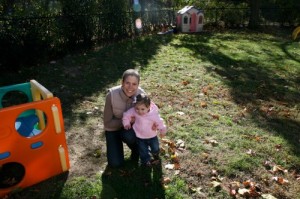
I had heard about the genetic test in my twenties, but I did not know that if I tested positive I could have up to an 85% risk of developing the disease and a 40% risk of developing ovarian cancer. I did not know that I could have had a prophylactic mastectomy that would lower my lifetime breast cancer risk to less than the U.S. national average, which is currently 12%.
However, I do not live in the past. I have embraced my cancer journey and all that has come with it.
Having this knowledge will benefit my sisters and my children most of all.
We make life choices that promote health and wellness and I feel that is a gift I can give my children. One day, they will be armed with the knowledge they will need to make informed decisions as they become old enough to have the genetic testing.
FORCE, Facing our Risk of Cancer Empowered, is a non-profit organization dedicated to supporting families affected by hereditary breast and ovarian cancer through education, support, and resources. There are local chapters throughout the United States and in other countries including Canada, Israel, and Australia. The World Health Organization reports that in 2010 there was more than 1.6 million cases of breast cancer worldwide, making it the top cancer for women in the developed and developing world. Although BRCA mutations are a just a small portion of these cases, there are certain groups that are at higher risk of carrying the mutation. These are people with Ashkenazi (Eastern European) Jewish ancestry and people of Norwegian, Dutch, and Icelandic ancestry.
I am now the Raleigh, NC area FORCE Outreach Co-Coordinator and we are a resource for women in the North Carolina area that have a strong family history of breast cancer or have tested positive for the BRCA mutation. We have support group meetings and work with the local genetic counselors. I am very excited to help bring support and education to families affected by hereditary breast cancer and to make sure women have the information they need to make informed decisions. We need to be our biggest health care advocates and doctors need to get the word out on genetic testing and how it can save lives.
Pink-Tober is in full swing and I hope that we can ignore the commercialism of it (and the giant pink pigs) and focus on its real purpose. Early detection saves lives! If you have a family history, please speak with a local genetic counselor.
If you notice a lump, or any changes in your breasts, get it checked out and don’t allow your concerns to be dismissed by your doctors.
Too many of our mothers, sisters, aunts, cousins, and daughters are losing their battle to this terrible disease. Until there is a cure, we need to focus on education, surveillance, and early detection.
To find out more about FORCE and hereditary breast and ovarian cancer please visit http://www.facingourrisk.org
To find out more about breast cancer in young women go to
http://www.youngsurvival.org
Risk factors for hereditary breast and ovarian cancer
http://www.facingourrisk.org/information_research/publications/documents/brochures-family-history.pdf
From the FORCE website:
How are hereditary cancers different?
- Hereditary cancer tends to occur at an earlier age than the sporadic form of the same cancer, so screening and risk-lowering recommendations for hereditary cancer may be different and may begin at an earlier age
- Hereditary gene changes and the accompanying increased risk for cancer can be shared by relatives and passed on to children.
- People with hereditary cancer have a higher risk for more than one type of cancer. In people who have already been diagnosed with a cancer, this may affect their cancer treatment or follow-up care.
- Specific screening or risk-lowering options are recommended for people at high risk for certain types of hereditary cancer.
Note: If you believe that breast or ovarian cancer runs in your family, you should contact a cancer genetic counselor, geneticist, or equally-qualified health care provider. These health care professionals can help determine your risk for hereditary cancer, inform you of available genetic tests and their benefits and limitations, order appropriate genetic tests, assist with insurance reimbursement of tests, and interpret the test results.

This is an original guest post to World Moms Blog. Katerina is a mom to Nathaniel, 6 and Lillian,4 and two labs Sasha and Dakota. She is a NJ native and recently relocated to Chapel Hill, North Carolina. Kat helped to start a young survivor breast cancer support group at UNC. She is happiest when she is enjoying the fresh air with her family, especially at the beach. Kat is passionate about nutrition and health. She feels so fortunate for every day that she get to spend with her husband and children. Every day is a gift.
Photo credit to Katerina Gmitter
World Moms Blog is an award winning website which writes from over 30 countries on the topics of motherhood, culture, human rights and social good. Over 70 international contributors share their stories from around the globe, bonded by the common thread of motherhood and wanting a better world for their children.
World Moms Blog was listed by Forbes Woman as one of the "Best 100 Websites for Women 2012 & 2013" and also called a "must read" by the NY Times Motherlode in 2013. Our Senior Editor in India, Purnima Ramakrishnan, was awarded the BlogHer International Activist Award in 2013.
More Posts

by Jennifer Burden | Oct 18, 2013 | 2013, Education, Family, Health, Home, Human Rights, Humanitarian, Inspirational, Kids, Natural Disaster, Philanthropy, USA, World Events, World Motherhood
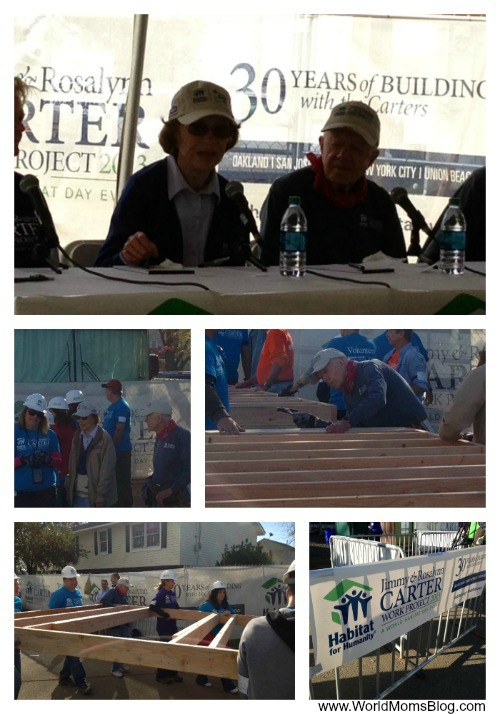
When it comes to helping people outside the United States, Former President Jimmy Carter says, “We don’t distinguish.”
In celebration of this week’s World Habitat Day, Carter said last Saturday, “We think the folks [we build housing for] in other countries are just as good and needy as the folks in America.”
The message that President Jimmy Carter and First Lady Rossalyn Carter brought to Union Beach, NJ, a town that was hit by Hurricane Sandy almost one year ago, was one of hope, for the people there and the people all around the world.
The Carters have spent over 3 decades giving a hand up to families in need of affordable shelter through Habitat for Humanity, a Christian non-profit that builds housing for the people who need it most. And, by the looks of it, they are not stopping. Last week, on the Habitat for Humanity work site in Union Beach, NJ, the President and First Lady, in their work clothes, helped build house framing for over 2 hours. (They are for real, guys.) This was the tail end of the Carter work project this year that went around the United States and ended in New Jersey.
The local branch of Habitat for Humanity in Monmouth County, New Jersey, USA, has completed 40 homes since Super Storm Sandy hit in October of last year. Eighty percent of their service area was affected by the storm from the town of Aberdeen to the town of Ocean.
First Lady Rossalyn Carter stated, “This [worksite] was a special one for us. Super storm Sandy hit, and we’ve been worried about you all ever since.”
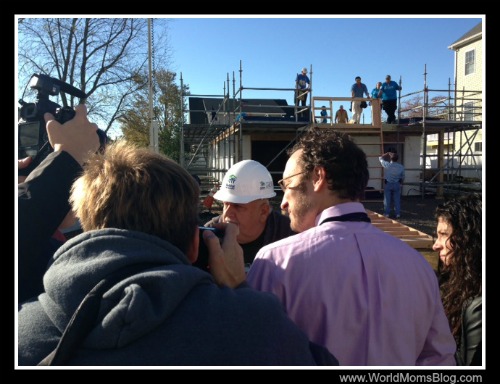
Mr. Lamberson is interviewed by the Press on the Carter’s worksite. That’s his home in the background being rebuilt after Super Storm Sandy damaged it almost one year ago.
The Carters have proved themselves tireless champions of human justice.
“We find that Habitat home owners were hopeless and have never known success. They’ve been promised outside help that never arrived, but Habitat is not that way. Local people decide what kind of houses to build, where and which families. Lots of the homeowners become transformed.” — President Carter.
The Former President also explained that the houses in Union Beach were being raised by 8 feet to withstand any future super storms. He said, “Places have to be prepared for the next natural disaster.”
The Habitat model is not a 100% hand out. Homeowners pay the full cost of the house, and they must put in at least 100 hours of work. However, in most cases, their mortgage is 0% interest.
And the organization requests their volunteers fundraise or pay to help, as well as, dedicate their woman and man hours.
Former First Lady Rossalyn Carter explained that education can be greatly effected when children do not have a home, and she referred to a family in Seattle, Washington, USA who were living in their automobile. After they moved into their Habitat home, their son became top of his class just months after moving into their Habitat home.
The Former First Lady described another mother who previously cringed to answer her door to her substandard housing because it was often the police saying that her sons were in trouble. Her sons were never home. After Habitat arrived and built them a new house, her sons returned home with their friends because they were proud of where they lived and were staying out of trouble.
These are the types of examples that keep the Carters going and using their celebrity to further the cause for adequate housing.
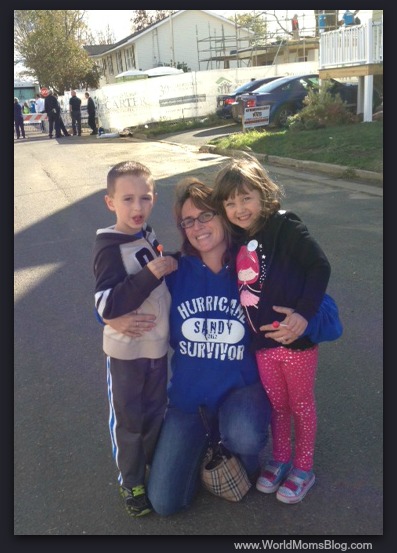
“Hurricane Sandy Survivor” — Kelly is a mom of twins whose home was flooded in Super Storm Sandy last year. Her family is still displaced and waiting for work on their home to be finished almost one year later (not a Habitat home). She came by with her kids to catch a glimpse of the Carters on Saturday.
“When we go to South Africa, South Korea, the Philippines, Europe, Hungary , and 3 times in Mexico, people are the same wherever we go.” — Former First Lady Rossalyn Carter
Exactly.
This is an original post to World Moms Blog by Founder, Jennifer Burden in NJ, USA. Jennifer is no stranger to Habitat for Humanity. As a junior at Villanova University, she spent a week building an adobe-style house in New Mexico, USA for a low-income family through the organization.
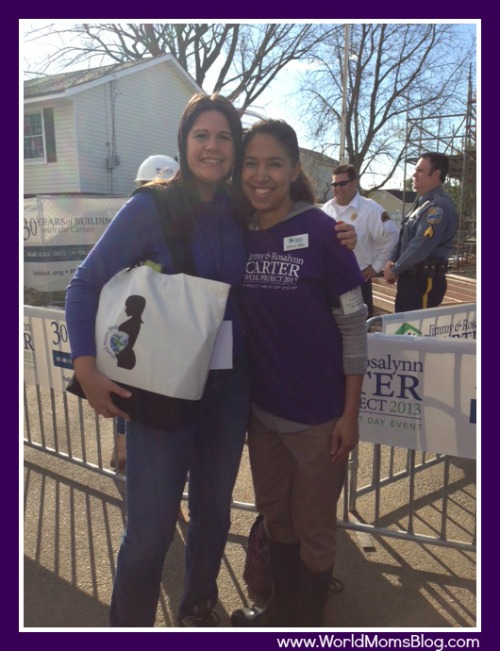
Jennifer Burden of World Moms Blog with Jennifer Sneed of Habitat for Humanity in Monmouth County, NJ at the Carter worksite in Union Beach, NJ on October 12, 2013.
Photo credits to the author.
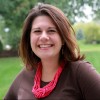
Jennifer Burden is the Founder and CEO of World Moms Network, an award winning website on global motherhood, culture, human rights and social good. World Moms Network writes from over 30 countries, has over 70 contributors and was listed by Forbes as one of the “Best 100 Websites for Women”, named a “must read” by The New York Times, and was recommended by The Times of India.
She was also invited to Uganda to view UNICEF’s family health programs with Shot@Life and was previously named a “Global Influencer Fellow” and “Social Media Fellow” by the UN Foundation. Jennifer was invited to the White House twice, including as a nominated "Changemaker" for the State of the World Women Summit. She also participated in the One Campaign’s first AYA Summit on the topic of women and girl empowerment and organized and spoke on an international panel at the World Bank in Washington, DC on the importance of a universal education for all girls. Her writing has been featured by Baby Center, Huffington Post, ONE.org, the UN Foundation’s Shot@Life, and The Gates Foundation’s “Impatient Optimists.” She is currently a candidate in Columbia University's School of International and Public Affairs in the Executive Masters of Public Affairs program, where she hopes to further her study of global policies affecting women and girls.
Jennifer can be found on Twitter @JenniferBurden.
More Posts - Website
Follow Me:


by Ruth | Oct 17, 2013 | Domesticity, Family, Health, Life Balance, Life Lesson, Ruth Wong, Singapore, World Motherhood

Credit: FrameAngel, freedigitalphotos.net
My mom has just been diagnosed with dementia. I knew it in my heart even before the geriatrician announced his diagnosis. The signs were there – her poor memory, her inability to reason, and in recent times, her increased anxiety and (almost incessant) repetitive questioning. That last bit has been the hardest part to deal with.
At the moment, I am very blessed to have a good live-in helper. But her work contract is coming to an end soon and I am not confident that she will stay. If I’m in her position, I’ll choose to work elsewhere. It is one tough job.
So a thought that I have pushed away for a while is resurfacing: Should I send my mom to a nursing home?
While it seems common for people in the ‘West’ to live in a nursing home in their old age, the decision to send one’s parents to an old folks’ home in this part of the world is often imbued with moral implications.
Here, we are inculcated with the value of filial piety from young and children are expected to look after their parents in their old age. Sending one’s parents to a nursing home is often frowned upon as being unfilial.
A long time ago, I used to think the same way, too, that sending one’s parents to a nursing home is wrong. Back then, life was just black or white; grey was not accommodated. But after I graduated from university and started my first job as a medical social worker, it opened my eyes to the predicaments of caregiving and I realized my views had been too simplistic. Placing one’s parents in a home does not mean the children no longer love or care for their parents. Sometimes, it’s simply that the level of care required by the elderly person is beyond the children’s abilities to manage. (more…)

Ruth lives in Singapore, a tiny island 137 kilometres north of the equator. After graduating from university, she worked as a medical social worker for a few years before making a switch to HR and worked in various industries such as retail, banking and manufacturing. In spite of the invaluable skills and experiences she had gained during those years, she never felt truly happy or satisfied. It was only when she embarked on a journey to rediscover her strengths and passion that this part of her life was transformed. Today, Ruth is living her dreams as a writer. Ironically, she loves what she does so much that at one point, she even thought that becoming a mom would hinder her career. Thanks to her husband’s gentle persuasions, she now realises what joy she would have missed out had she not changed her mind. She is now a happy WAHM. Ruth launched MomME Circle, a resource site to support and inspire moms to create a life and business they love. She has a personal blog Mommy Café where she writes about her son's growing up and shares her interests such as food and photography.
More Posts
by Sarah Sensamaust | Oct 16, 2013 | 2013, Africa, Being Thankful, Cultural Differences, Expat Life, Health, Hospital, World Motherhood
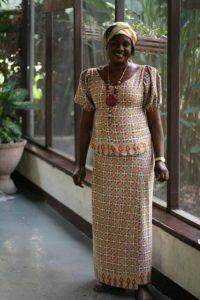
This summer our three-year-old daughter had her tonsils and adenoids removed. Many children have this routine surgery, but we still teared-up a bit as they wheeled her away. Then we enjoyed our coffee while we waited for the surgeon to tell us everything went “just fine.” Because we knew it would be. Even if there was a complication we rest assured in the fact that we were in the United States.
This summer Mama Youyou, our nanny in Congo, also had a routine surgery and we were scared out of our minds. Mama Youyou waited to have her surgery until we left for our summer break in the States so she wouldn’t have to take off work. (Bless her.) When she told us she needed the surgery, we did everything we could to make sure she had access to good health care.
You see, Mama Youyou has already outlived her life expectancy as a Congolese woman. Complications during routine surgeries in DRC, and lack of access to medical care, are the type of thing that keeps her life expectancy rate down. (more…)

by Ecoziva (Brazil) | Oct 14, 2013 | 2013, Babies, Being Thankful, Brazil, Child Care, Childhood, Culture, Domesticity, Eye on Culture, Family, Health, Home, Inspirational, Life Balance, Maternal Health, Me-Time, Motherhood, Parenting, Religion, Spirituality, Traditions, Working Mother, World Motherhood, Younger Children
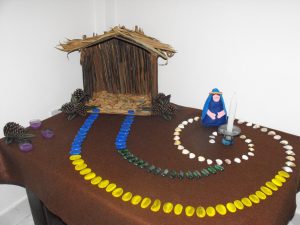 My maternity leave is now coming to an end, but throughout it a typical week day has meant about 12-14 hours alone with the kids.
My maternity leave is now coming to an end, but throughout it a typical week day has meant about 12-14 hours alone with the kids.
I usually wake up at 5:20 a.m. and my husband leaves with our eldest around six. I spend my mornings with our 2 ½ year old girl and our six month old baby boy. Our son returns from school approximately 1:30 p.m. Sometimes my husband returns early, but he usually gets home between 6 and 8 p.m. depending on traffic, his schedule, etc.
I love my kids dearly. Yet any mother knows that such a routine is not easy. On the typical day, by 6 p.m. my patience starts to wane. By nature I have a calm personality, but if there is screaming on my side, 90% of the time it will be after 6 p.m.
I once heard that 6 p.m. is one of the most difficult times of the day. On an individual level it is the time when stress peaks and on a collective level it is the time when most crime, car accidents and other such things happen. I don’t know if there is data backing that, but in a way it does make sense.
In my case, it is around 6 p.m. that the less-than-noble feelings will start to take over my mind, such as resentment, self-pity and repetitive worrying about pending work (although I have been legally on leave and have not been teaching, I did choose to maintain some activities from home). Other days I wish I could just stop working and truly be a full-time mother.
One thing that has helped is practicing acceptance and gratitude: A student sent me her research project two weeks ago and I haven’t even managed to open the file. Sorry, I am doing the best I can. My daughter has been screaming for 15 minutes in a temper tantrum. How great that she is healthy and her lungs are working! The kitchen sink is piled with dishes and the whole house is a mess. Things will get better as the kids grow older.
Of course it is easier said than done and one thing I try to do every day is to pray that my patience lasts past the kids’ bedtime.
I recently thought about how in the past it was a custom here in Brazil – a mostly catholic country – for the radios to play the Ave Maria in Latin at 6 p.m. In the small town I lived in when I was little, the Catholic church’s bells also tolled at six.
I haven’t been much of a radio listener for the past few years so I went on the web to check if the custom was still present. I learned it is a practice that has been carried out here in Brazil for the last 54 years. It comes from an old Portuguese tradition that in turn derives from the Angelus [*] – a Christian devotion recited at 6 a.m., midday and 6 p.m., which refers to Mary and the Annunciation. In simple terms, it is a time of prayer and meditation.
While reading about the 6 p.m. devotion and thinking about the emotional condition of mothers who spend the whole day alone with their children, I realized that it was the kind of practice that makes sense in the context of motherhood. After all, regardless of religion or debates on the specifics of Mary’s story, in a greater context she can be seen as a symbol of an inspiring and caring mother.
With that in mind, this week I am experimenting with short “Mary meditations” around 6 p.m. to see if it helps extend and deepen my patience and acceptance.
And you? What strategies do you use to help you face the challenges of the day-to-day motherhood routine?
[*] If there are any Catholics out there reading this and I am explaining this wrong please correct me! I was sort of raised Catholic in a Catholic country but I’m not actually Catholic, so I don’t have in-depth knowledge of the Angelus.
This is an original post to World Moms Blog from our devoted writer and mother of three in Brazil, EcoZiva.
The photo used in this post was taken by the author.
Eco, from the greek oikos means home; Ziva has many meanings and roots, including Hebrew (brilliance, light), Slovenian (goddess of life) and Sanskrit (blessing). In Brazil, where EcoZiva has lived for most of her life, giving birth is often termed “giving the light”; thus, she thought, a mother is “home to light” during the nine months of pregnancy, and so the penname EcoZiva came to be for World Moms Blog.
Born in the USA in a multi-ethnic extended family, EcoZiva is married and the mother of two boys (aged 12 and three) and a five-year-old girl and a three yearboy. She is trained as a biologist and presently an university researcher/professor, but also a volunteer at the local environmental movement.
More Posts

by Meredith (USA) | Oct 11, 2013 | Body Image, Childhood, Cooking, Domesticity, Exercise, Family, Food, Health, Kids, Life Lesson, Motherhood, Nutrition, Parenting, World Motherhood, Younger Children
 When I was growing up, I had a mother who loved to cook and bake. It wasn’t unusual for me to wake up smelling homemade cinnamon bread just out of the oven, and come home from school smelling homemade rolls for dinner.
When I was growing up, I had a mother who loved to cook and bake. It wasn’t unusual for me to wake up smelling homemade cinnamon bread just out of the oven, and come home from school smelling homemade rolls for dinner.
In my family, if you didn’t eat everything mom made on your plate, she worried there was something wrong with you.
(more…)
Meredith finds it difficult to tell anyone where she is from exactly! She grew up in several states, but mainly Illinois. She has a Bachelor of Science degree in Elementary Education from the University of Illinois at Champaign/Urbana which is also where she met her husband. She taught kindergarten for seven years before she adopted her son from Guatemala and then gave birth to her daughter two years leter. She moved to Lagos, Nigeria with her husband and two children in July 2009 for her husband's work. She and her family moved back to the U.S.this summer(August 2012) and are adjusting to life back in the U.S. You can read more about her life in Lagos and her adjustment to being back on her blog: We Found Happiness.
More Posts

















 When I was growing up, I had a mother who loved to cook and bake. It wasn’t unusual for me to wake up smelling homemade cinnamon bread just out of the oven, and come home from school smelling homemade rolls for dinner.
When I was growing up, I had a mother who loved to cook and bake. It wasn’t unusual for me to wake up smelling homemade cinnamon bread just out of the oven, and come home from school smelling homemade rolls for dinner.


